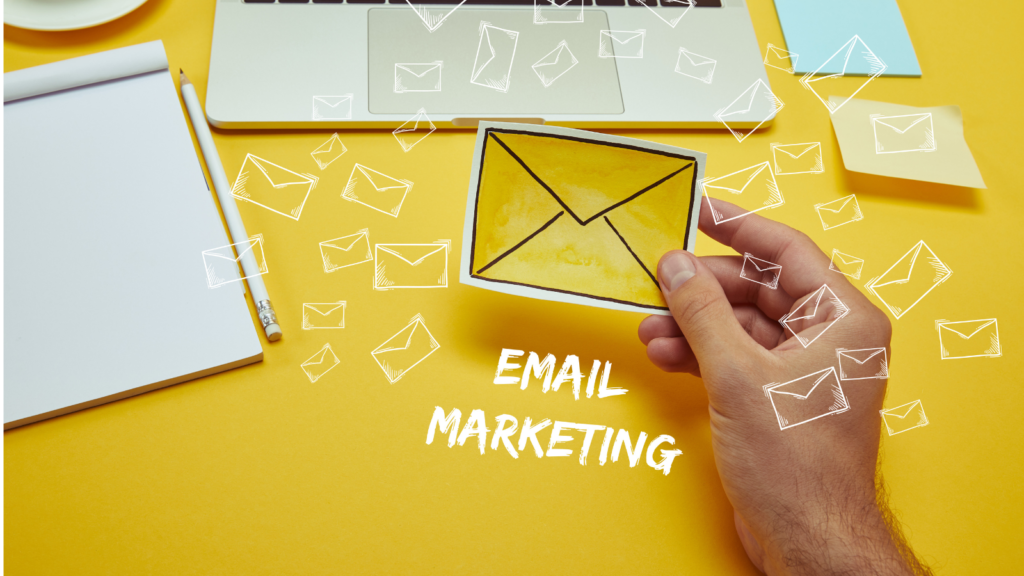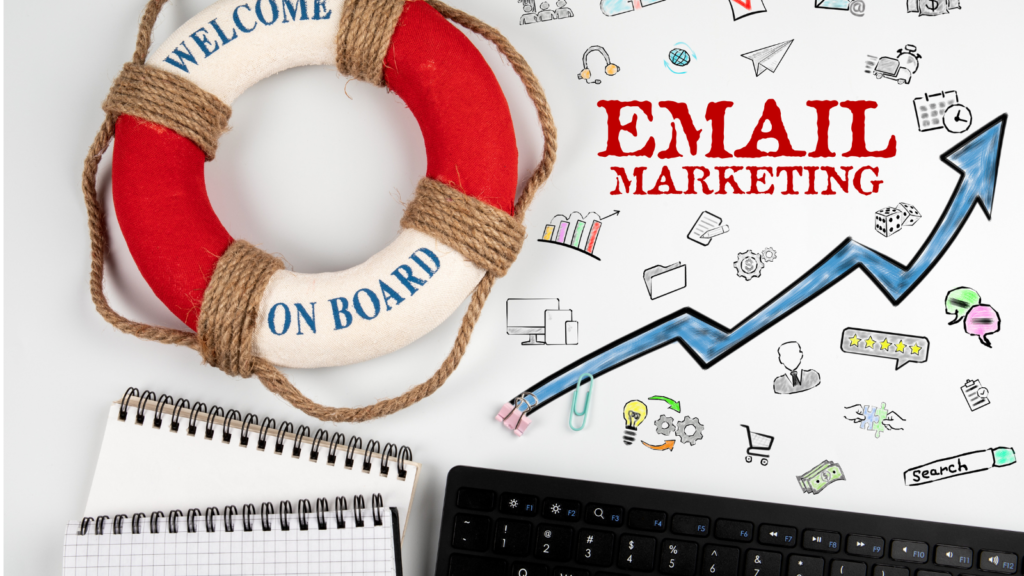In the digital marketing landscape, mastering the art of email communication is a pivotal strategy for businesses aiming to foster stronger connections with their audience.
This guide is crafted to elevate your click-through rates (CTR). This critical metric gauges the effectiveness of your email content and serves as a beacon, guiding your audience from curiosity to actionable outcomes.
Whether you’re refining existing strategies or laying the groundwork for new campaigns, this post will equip you with actionable insights to enhance the resonance and responsiveness of your email initiatives, ultimately driving more meaningful interactions and conversions.

#1 Craft Compelling Subject Lines
The subject line of an email acts as the gateway to your content, holding the power to entice recipients to delve deeper or bypass the message altogether.
In email marketing, crafting compelling subject lines is paramount, serving as the first and possibly the most crucial step in elevating your email click-through rates (CTR). A well-formulated subject line should ignite curiosity, convey urgency, or offer something of value, compelling the recipient to explore the contents of your email.
Incorporating action verbs can infuse your subject lines with energy and a sense of urgency, encouraging recipients to act. Personalisation, extending beyond the mere inclusion of the recipient’s name, can significantly increase the relevance of the email, making the offer appear tailor-made for the individual.
By sparking curiosity without veering into clickbait, your subject lines can be an irresistible invitation to uncover the value hidden within your email.
Remember, your subject line is your first impression; in the fast-paced digital world, it might be your only chance to capture attention. Testing various subject lines through A/B testing can provide valuable insights into what resonates most with your audience, allowing you to refine your approach and consistently improve your email engagement rates.
#2 Personalise Your Emails
In today’s saturated digital landscape, personalisation is no longer just an option but a necessity for cutting through the noise and connecting with your audience on a deeper level.
Personalisation is the second cornerstone to elevating your email click-through rates (CTR). This practice extends beyond addressing the recipient by name; it’s about crafting content that resonates with their unique interests, preferences, and past behaviours, making each email feel like a one-on-one conversation.
Segmentation is vital in personalisation. It allows you to group your audience based on specific criteria such as purchase history, engagement levels, or demographic information.
By understanding these segments, you can tailor your messages to meet the needs and desires of each group, increasing the relevance and appeal of your emails. For instance, sending targeted product recommendations based on previous purchases can make recipients feel understood and valued, significantly enhancing the likelihood of click-throughs.
Moreover, leveraging data like browsing behaviour and engagement patterns enables you to send emails that are not only timely but also highly relevant to the recipient’s current interests. For example, a follow-up email featuring items related to a recently viewed product can reignite interest and encourage further exploration.
Incorporating personalisation into your email strategy requires a deep understanding of your audience and the ability to use data effectively. However, when executed correctly, it can transform your emails from generic broadcasts into personalised messages that captivate and engage, driving higher click-through rates and a stronger connection with your audience.
#3 Optimise Your Email Design
In the digital age, where the aesthetic appeal of content can significantly impact user engagement, the design of your email plays a critical role in increasing your click-through rates.
An optimised email design ensures that your message is delivered effectively and resonates with the recipient, encouraging them to take action.
A key aspect of email design is its responsiveness across different devices. With many emails being opened on mobile devices, ensuring your email looks and functions seamlessly on smartphones and tablets is non-negotiable.
This involves using a mobile-responsive template, keeping the layout simple, and scaling images correctly to enhance readability and usability on smaller screens.
Visual elements within your email can act as powerful catalysts for engagement. Utilise high-quality images, infographics, or videos that complement and amplify your message.
However, it’s crucial to maintain a balance; excessive visuals might overshadow your call-to-action (CTA) or slow down the loading time, potentially deterring readers.
The hierarchy of your content is another vital component. Strategically place the most important information or offers at the top, ensuring they capture attention even in a quick scan. Clear, concise headings and bullet points can improve readability and guide the reader through the email content towards the CTA.
Finally, the colour scheme and font choice should not only align with your brand identity but also contribute to the clarity and attractiveness of the email. Contrasting colours can make your CTA stand out, while a readable font ensures that the audience effortlessly absorbs your message.
By prioritising a responsive, visually appealing, and well-structured email design, you can significantly enhance the user experience, making it more likely that recipients will engage with your content and, more importantly, click through to your desired destination.

#4 Use Clear and Compelling CTAs
The call-to-action (CTA) is the pivotal moment in your email where you convert a reader’s interest into tangible engagement. Crafting a clear and compelling CTA is not just a best practice; it’s necessary to boost your email click-through rates.
Your CTA should stand out as the beacon of what you want the reader to do next: learn more about a product, take advantage of a special offer, or participate in a survey.
A successful CTA is concise and action-oriented, using verbs that inspire action, such as “Discover,” “Join,” or “Get Started.” The language should be direct and imbue a sense of urgency or benefit, making it clear what the reader can gain by clicking. For instance, “Claim Your Free Trial Today” is more compelling than a vague “Click Here.”
Design plays a crucial role in making your CTA buttons noticeable and clickable. Using contrasting colours and sufficient white space around your CTA can make it stand out from the rest of your email content.
The placement is equally important; ideally, your CTA should be placed above the fold, making it visible without scrolling, and repeated at the end for those who read the entire email.
Testing different CTA designs, placements, and messages through A/B testing can reveal what resonates best with your audience, allowing you to optimise for higher click-through rates.
Remember, your CTA bridges the recipient’s interest and desired action; making it as straightforward and compelling as possible can significantly impact your email campaign’s success.
#5 A/B Test Your Emails
In the quest to maximise email click-through rates, A/B testing emerges as an indispensable strategy. It offers a data-driven approach to understanding your audience’s preferences. This practice involves sending two variations of your email to a small audience segment to see which version performs better before rolling out the winning version to the broader list.
The elements subject to testing can range from subject lines and email content to images, layout, and CTAs, providing a comprehensive understanding of what engages your recipients most effectively.
The key to successful A/B testing is changing one element at a time. This approach ensures that you can pinpoint exactly which change made the difference in performance. For instance, if you’re testing subject lines, keep the email content constant to accurately measure the impact of the subject line variations on open and click-through rates.
Incorporating A/B testing into your email marketing strategy enhances the effectiveness of your campaigns and offers deeper insights into your audience’s preferences and behaviours. This continuous loop of testing, learning, and optimising enables you to craft emails that resonate more profoundly with your audience, increasing engagement and conversions.
Furthermore, leveraging the insights gained from A/B testing can inform broader marketing strategies, aligning your content and messaging across channels to the preferences demonstrated by your audience in the email tests.
This holistic approach ensures consistency in your brand communication, amplifying the impact of your marketing efforts across the board.
#6 Ensure Your Emails Are Mobile-Friendly
With most emails being opened on mobile devices, ensuring your emails are mobile-friendly is not just a best practice—it’s essential. A mobile-friendly email ensures your content is easily readable and engaging on any device, particularly smartphones and tablets.
This adaptability enhances the user experience and significantly impacts click-through rates, as recipients are more likely to engage with content that is accessible and easy to navigate on their preferred device.
To optimise your emails for mobile, focus on responsive design. This means your emails should automatically adjust to fit the screen size of the device they’re viewed on, ensuring that text is readable, images are correctly sized, and CTAs are easily clickable without zooming in or out.
A single-column layout, large, legible fonts, and buttons instead of links for your CTAs can further improve the mobile experience.
Additionally, consider the loading time of your email. Heavy images or complex HTML can slow loading times, which is particularly frustrating for mobile users. Optimise images for the web and test your emails across different devices and email clients to ensure they load quickly and display correctly.
Incorporating these mobile-friendly practices into your email design caters to the growing mobile audience. It reflects your brand’s attentiveness to user experience, potentially leading to higher engagement and click-through rates from your email campaigns.
Remember, in today’s mobile-first world, an email that isn’t optimised for mobile might as well not be sent at all.

#7 Leverage the Power of Storytelling
Incorporating storytelling into your emails can significantly enhance their engagement and click-through rates. Stories captivate the human mind, making content more memorable and impactful.
By weaving narratives around your products, services, or brand, you can connect with your audience on a deeper emotional level, making your emails not just a message but an experience that resonates.
Compelling email storytelling often involves sharing customer success stories, behind-the-scenes looks into your company, or narratives that align with your brand’s values and mission. These stories should be compelling and relevant to your audience’s interests and needs, making the content personalised and thoughtful.
When integrating storytelling into your email strategy, ensure each story has a clear message and ties back to a specific call-to-action (CTA). This connection is crucial as it guides the reader from being engrossed in a story to taking a tangible step that benefits them and your business, such as purchasing, signing up for a webinar, or downloading a resource.
Moreover, the structure of the story is essential. Begin with an engaging hook that draws readers in, followed by the body of the story, which builds context and emotional investment, and conclude with a satisfying resolution that naturally leads into your CTA.
This narrative arc keeps readers engaged and makes the subsequent CTA feel like a natural progression rather than a sales pitch.
Embracing storytelling can transform your emails from simple communications to captivating narratives that foster a strong connection with your audience, encouraging higher click-through rates and deeper engagement with your brand.
#8 Time Your Emails Strategically
Timing is a crucial factor in the success of your email campaigns, directly influencing open rates and, subsequently, click-through rates. Strategic timing ensures that your emails land in your recipients’ inboxes when they are most likely attentive and receptive.
This involves understanding not just the best days of the week but also the optimal times of day for your specific audience.
Research and data analysis play key roles in identifying these prime sending times. While general trends suggest certain days and times tend to yield higher engagement rates—like mid-week mornings—these can vary significantly depending on your industry, audience demographics, and even the nature of the content you’re sending.
To refine your timing strategy, consider segmenting your email list based on time zones to ensure your emails reach recipients during their waking hours. Additionally, different segments of your audience exhibit unique behaviours, with some groups more likely to engage in the evenings or weekends.
Tailoring your send times to these patterns can enhance the relevance and impact of your communications.
Leveraging email automation tools can facilitate this process, allowing you to schedule your emails based on the optimal times. Moreover, some advanced platforms offer send-time optimisation, automatically adjusting sending times based on when individual recipients are most likely to open and engage with emails.
Remember, the goal is to integrate your emails into the natural flow of your recipients’ daily lives, making each message a welcome and timely addition to their inbox.
By aligning your email campaigns with the rhythms of your audience’s routine, you can significantly improve the chances of your emails being opened, read, and acted upon.
#9 Keep Your Email List Clean
Maintaining a clean and updated email list is a cornerstone for enhancing your email click-through rates. A clean list ensures that your emails reach engaged and interested subscribers, improving overall engagement rates and reducing the risk of your emails being marked as spam.
Regularly auditing your email list to remove inactive subscribers, incorrect email addresses, and opted-out subscribers keeps your audience base healthy and responsive.
A key strategy for keeping your email list clean is implementing a re-engagement campaign targeting subscribers who have not interacted with your emails over a certain period. This approach allows you to identify inactive subscribers from those who may still be interested but have yet to have the chance to engage.
Subscribers who don’t respond to re-engagement efforts should be removed to ensure your list reflects an audience genuinely interested in your content.
Another aspect of maintaining a clean email list is ensuring that subscribing and unsubscribing are straightforward and user-friendly. This adheres to best practices and legal requirements and respects your audience’s preferences, contributing to a positive perception of your brand.
In addition, consider using double opt-in methods for new subscribers. This practice confirms that the email address is valid and that the subscriber genuinely wants to receive emails from you, further ensuring the quality of your email list.
A clean email list leads to higher deliverability rates, better engagement, and improved click-through rates. By investing time in regularly cleaning your email list, you’re investing in the quality and effectiveness of your email marketing campaigns, ensuring that your messages reach a receptive and interested audience.
Conclusion
In navigating the complex currents of email marketing, pursuing higher click-through rates is a testament to the ongoing dialogue between brands and their audiences.
From the artistry of crafting compelling subject lines to the precision of A/B testing, each practice unveils a layer of potential waiting to be harnessed. Personalisation, mobile optimisation, and the compelling power of storytelling stand as pillars that support a robust email campaign, while the strategic use of CTAs converts reader interest into tangible action.
Remember, the journey doesn’t end with implementing these practices; it’s a continuous cycle of testing, learning, and evolving. The digital landscape is ever-changing, and so are your audience’s preferences.
Keeping your email list clean and adhering to best practices uplifts your brand’s message and ensures it resonates in today’s crowded inboxes.
As you embark on or continue refining your email marketing journey, consider these practices not as checkboxes but as tools for crafting more meaningful, engaging, and effective email campaigns.
Test, adapt, personalise, and watch your click-through rates—and, more importantly, your connections with your audience—flourish.
FAQs
Q1: How significant is the subject line in improving email click-through rates?
A1: The subject line is crucial as it serves as the first impression of your email. A compelling subject line can significantly influence the recipient’s decision to open the email and engage with its content, directly impacting click-through rates.
Q2: Can personalisation make a difference in email campaigns?
A2: Absolutely. Personalisation extends beyond addressing the recipient by name; it involves tailoring the email content to match the recipient’s interests, behaviours, and past interactions, making the email more relevant and likely to elicit a click-through.
Q3: Why is A/B testing important in email marketing?
A3: A/B testing allows marketers to compare two versions of an email to see which performs better. This data-driven approach helps understand what resonates with the audience, enabling continuous optimisation of email campaigns for better performance.
Q4: How does the design of an email impact its click-through rate?
A4: The design of an email, including its layout, use of images, and especially the visibility and appeal of the CTA, plays a significant role in guiding the recipient’s journey from reading to taking action, thereby affecting click-through rates.
Q5: What role does mobile optimisation play in email marketing?
A5: With the increasing prevalence of mobile devices for checking emails, mobile optimisation ensures that your emails are accessible and visually appealing across all device types, essential for maintaining high engagement and click-through rates.
Q6: How often should I clean my email list?
A6: Regularly cleaning your email list, at least once every six months, is recommended to remove inactive subscribers and maintain a high-quality list of engaged recipients, contributing to better email performance and deliverability.
Q7: Is storytelling compelling in emails?
A7: Storytelling can boost engagement by making emails more relatable and memorable. A well-told story can evoke emotions and create a connection with the audience, leading to higher click-through rates as recipients are more invested in the content.




